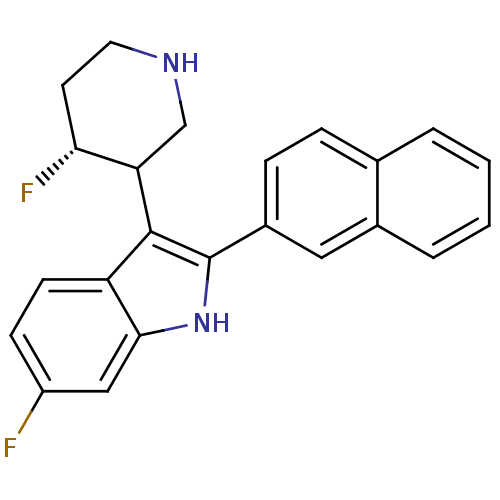BDBM50099258 6-Fluoro-3-(4-fluoro-piperidin-3-yl)-2-naphthalen-2-yl-1H-indole::CHEMBL297136
SMILES F[C@@H]1CCNCC1c1c([nH]c2cc(F)ccc12)-c1ccc2ccccc2c1
InChI Key InChIKey=DAUSNPVLXKKGNQ-GFOWMXPYSA-N
Data 4 KI
Activity Spreadsheet -- Enzyme Inhibition Constant Data from BindingDB
 Found 4 hits for monomerid = 50099258
Found 4 hits for monomerid = 50099258
Target5-hydroxytryptamine receptor 2A(Homo sapiens (Human))
Merck Sharp and Dohme Research Laboratories
Curated by ChEMBL
Merck Sharp and Dohme Research Laboratories
Curated by ChEMBL
Affinity DataKi: 0.230nMAssay Description:Ability to displace [3H]-ketanserin binding to human 5-hydroxytryptamine 2A receptor stably expressed in CHO cellsMore data for this Ligand-Target Pair
TargetPotassium voltage-gated channel subfamily H member 2(Homo sapiens (Human))
Astrazeneca
Curated by ChEMBL
Astrazeneca
Curated by ChEMBL
Affinity DataKi: 500nMAssay Description:Inhibition of human ERG channelMore data for this Ligand-Target Pair
TargetD(2) dopamine receptor(Homo sapiens (Human))
Merck Sharp and Dohme Research Laboratories
Curated by ChEMBL
Merck Sharp and Dohme Research Laboratories
Curated by ChEMBL
Affinity DataKi: 500nMAssay Description:Ability to displace [3H]-spiperone binding to CHO cells stably expressing dopamine receptor D2More data for this Ligand-Target Pair
TargetPotassium voltage-gated channel subfamily H member 2(Homo sapiens (Human))
Astrazeneca
Curated by ChEMBL
Astrazeneca
Curated by ChEMBL
Affinity DataKi: 500nMAssay Description:Displacement of [3H]-dofetilide from HEK cells expressing hERG voltage dependent IKr potassium channel Kv11.1More data for this Ligand-Target Pair
